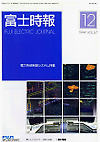FUJI ELECTRIC JOURNAL Vol.67-No.12 (Dec/1994)
 |
Supervisory Control and Data Acquisition systems for Power Systems |
Present Status and Trends of Supervisory Control and Data Acquisition Systems for Power Systems
Yoshihiro Niinaga
In the trend of the times where all information processing systems are rapidly developing towards open/distributed systems, the next-generation control system for power systems will innovate into function-distributed systems, maintaining existing real-time functions, multi-task processing efficiency, and reliability. Further, it is expected that the man-machine interface will be sophisticated along with the wider use of workstations and support functions for facilitating power system operation will be fully prepared.
Present Status and Trends of Tele-Control Equipment for Electric Power Systems
Yukinobu Furukawa, Keijiro Ishii, Satoshi Yamagishi
For tele-control equipment for electric power systems, the cyclic procedure was used over 15 years; then the highlevel data link procedure has come into practical use, and the information processing quantity, transmission speed, response time characteristics, and processing function have greatly improved. In the technology of connection to power plant and substation equipment, particularly serial interfacing using LAN and other transmission technologies as the core has been studied towards practical use. This paper describes the present status of tele-control equipment compared to the former one and trends for the near future.
SCADA System for Niigata Local Load Dispatching Office, Tohoku Electric Power Co., Inc.
Akitomo Ohtsubo, Toshiya Saitoh, Atsushi Watanabe
With the expansion and sophistication of power systems, demand for improvement in the reliability and quality of power supply has increased. To meet the requirements for sophisticated power system operation and efficient office work, Fuji Electric carried out the innovation of the SCADA system of Niigata Local Load Dispatching Office, Tohoku Electric Power Co., Inc. This distributed function system has introduced new functions such as state estimation, connection to intelligent tele-control systems, and communication with the main frame as well as enhanced conventional functions.
Wakayama Dispatching Center System of The Kansai Electric Power Co., Inc.
Kazuhiko Ikegami, Takeo Shinoda, Kiyoshi Suzuki
The Wakayama Dispatching Center system is a computer-aided dispatching system capable of operating complex, sophisticated power systems. The system uses A-120 for the computer, IVC-800R and a mouse for the man-machine interface, and 3 consoles for operation. It is characterized by rich information processing functions such as communication to the emergency disaster relief center, automatic fax transmission, and display of areas under power failure on the map. The system has mechanized and reduced labor for daily routines by means of the automatic writing of operation slips and brief reports on faults.
Dispatching Center System for Matsumoto Region, Chubu Electric Co.,Inc.
Sakae Oguchi, Katsunori Fujioka, Satoru Takahashi
Chubu Electric Power Co., Inc. divided control centers under Nagano Branch from existing Nagano Dispatching Center, and Fuji Electric has supplied the company with a dispatching center system that brings Matsumoto region under integrated control. This paper introduces features of its computer system configuration of high performance and function and its functional specification for linking with other centers and data maintenance. It refers to the training equipment delivered at the same time which aims at operators' learning and acquiring skill of basic technique required for system restroration as well as technical improvement.
Computer System for Regional Power System Control Centers, Shikoku Electric Power Co., Inc.
Naoto Kobayashi, Isamu Misawa
To operate a large, complex power system from the system control center, the operator is required to have wide, sophisticated knowledge and technology, and his quick and exact judgment is demanded for emergency action against faults and for taking measures and coordination to secure system reliability against a shutdown. Fuji Electric put to practical use a system for these system operation tasks using up-to-date technology such as AI: The system gives operators information quickly and plainly, and also it has advanced training equipment to support them enough to learn a method of restoring the system when a fault occurs.
Horai and Shinobu Dam Control System, Tohoku Electric Power Co., Inc
Seiichi Takahashi, Koichiro Hosokawa, Masaaki Soufuku
To control river water of nature, dam operation requires operator's high-grade judgment and speedy reaction when the river swells. Fuji Electric supplied a dam control system for Horai and Shinobu Dams, Tohoku Electric Power Co., Inc. This system fully automates dam operation such as dam gate operation and logging. Up-to-date technologies, including workstations and optical LAN, have been introduced to reduce operators'load and realize safer and higher grade dam operation. Dam operation routines such as gate operation and recording are fully automated.
SCADA System for Imaichi Hydroelectric Station Control Office, Tochigi Prefecture
Takashi Matsunuma, Maki Shiroto, Shigemitsu Yamasawa
Electric power companies have already adopted a lot of SCADA systems capable of controlling hydroelectric stations and substations from one control center, most of which are based on duplex computers. On the other hand, many public enterprises are now going to adopt this system. In this situation, Fuji Electric has supplied a SCADA system to the Enterprise Agency of Tochigi Prefecture. This paper gives an outline of the whole system, features of each equipment, and its noteworthy functions, in addition to transitions of the scope of the scope of maintenance and control of the hydroelectric station.

